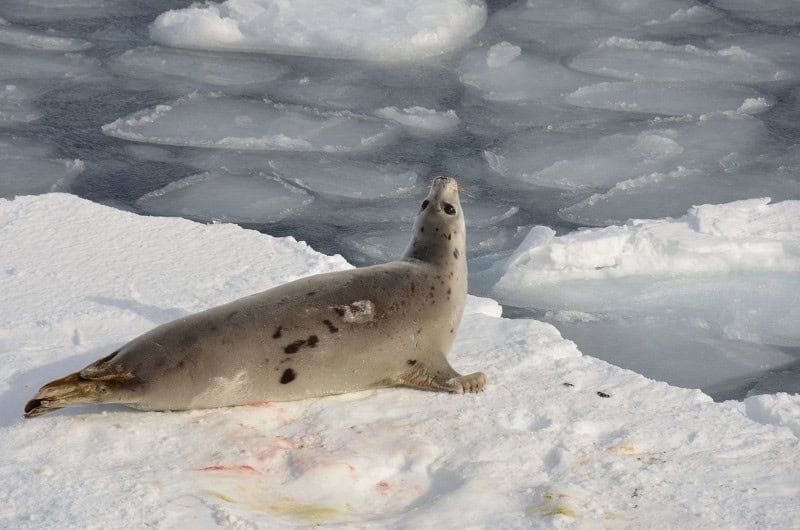
Harp Seal Facts
- A true marvel of Nature and evolution, this majestic creature most frequently goes by the simple common name of the Harp Seal. It does have a few other, less often used titles, though. Those multiple alternates include the terms Greenland Seal and Saddleback Seal.
- Among scientific professionals, though, it’s more typically referred to by its current formal name. That particular moniker, however, remains extremely difficult for the layperson to pronounce. That’s true given that its official title is that of the Pagophilus groenlandicus.
- The remarkable Pinniped received that tongue-twisting appelation due to the efforts of the German naturalist, Johann Christian Polycarp Erxleben. The highly noted researcher accomplished the first official recognition of it as a separate and distinct species in 1777.
- This impressive masterpiece of Nature classifies as a variety of earless seal, otherwise known as a true seal. It also stands out for a somewhat surprising reason. That’s because this distinctive species of seal currently represents the only known extant member of its entire genus.
- Thankfully, however, the population base of the Harp Seal appears to have rebounded from the past, when it was hunted without restriction. It now has relatively stable and sizeable numbers. The IUCN thus lists the mammal as Least Concern on its Red List of Threatened Species.
- The amazing animal nevertheless still faces various threats to its continued existence as a species. This natually includes the existence of ongoing hunting practices. Yet it also must deal with the dual dangers posed by habitat loss and the ongoing effects of climate change.
Related Articles
Harp Seal Physical Description
The stunning Harp Seal constitutes one of those fauna that effortlessly captures your attention when you encounter it. Unlike some species around the world, however, it does so for more than just one reason. This holds true due to the fact that it’s both beautiful and relatively sizeable.
Like the great majority of its kindred, though, it also displays a certain degree of the physiological characteristic of sexual dimorphism. In its specific case, however, the animal distinguishes itself further. For this seal, that attribute appears in terms of both size and basic appearance.
Males of this amazing mammal typically attain a slightly greater size than their female counterparts. These grow to an average length measuring approximately 6.2 ft (1.9 m). In terms of weight, the males generally reach around 298 lb (135 kg). These also end to have a larger hump on their back.
Females, meanwhile, usually reach sizes that, while smaller, aren’t significantly so. These individuals attain an average body length equaling about 5.9 ft (1.8 m). Their body mass likewise remains lighter, but, not surprisingly, not by much. They grow to an average weight of around 260 lb (120 kg).
In terms of coloring, though, both genders of the mesmerizing Harp Seal present roughly the same visual pattern. Mature specimens present a background composed of silver-gray fur, with distinctive black harp-shaped patterns on the upper back. Adults also generally have pure black eyes.
But the young of this wonder of Nature typically present a vastly different appearance. This slowly changes as the individual ages. Newborns show pure white for the first few weeks of life. During adolescence, though, this changes to a silver-gray, marked with multiple small black spots.
- Kingdom: Animalia
- Phylum: Chordata
- Class: Mammalia
- Order: Carnivora
- Family: Phocidae
- Genus: Pagophilus
- Species: P. groenlandicus
Harp Seal Distribution, Habitat, and Ecology
The beautiful Harp Seal evolved as native to a moderately large portion of the earth’s surface for its kind. The precise location and nature of that zone of habitation will likely not surprise anyone, though. That’s because this marvelous species of seal lives in the upper Northern Hemisphere.
More precisely, the animal largely lives within sections of the Arctic Ocean. A smaller percentage, however, also make their home in the more northerly portions of the Atlantic Ocean, as well. For the moment, it’s unknown if it ever lived anywhere beyond that known territorial range.
Not surprisingly, given this indigenous zone of habitation, the gorgeous mammal displays decided preferences in its choice of habitat. Most specimens spend the great majority of their time in the open sea. They do spend a small portion of their lives on the surrounding ice, though.
Again following patterns common to Pinnipeds, the impressive animal lives as a highly social creature. Overall, examples typically live in extremely large colonies, often numbering in the thousands. Within this larger mass, however, smaller groups also usually form their own hierarchies.
Like most of its kind, the Harp Seal developed as a purely carnivorous species. It does have a surprisingly diverse diet, though. The creature feeds on a variety of invertebrate and fish species, totalling several dozen different species. Precise prey depends upon an individual’s location.
The animal in turn has its own fair share of predators, to be sure. Juveniles frequently fall victim to the attacks of several land-based hunters, such as wolves and Polar Bears. Mature adults, meanwhile, face attacks by various larger types of sharks, as well as Orcas across their entire range.
Species Sharing Its Range
Check out our other articles on 5 Beautiful North American Birds, Southern Darwin’s Frog, Mount Vesuvius, Eastern Cicada Killer, Philippine Cobra, Red Maple, Snowflake Moray
